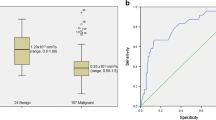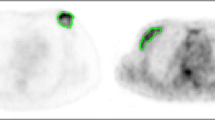Abstract
Objectives
This study investigated whether texture-based imaging parameters could identify invasive components of ductal carcinoma in situ (DCIS).
Methods
We enrolled 65 biopsy-confirmed DCIS patients (62 unilateral, 3 bilateral) who underwent 18 F-FDG PET, diffusion-weighted imaging (DWI), or breast-specific gamma imaging (BSGI). We measured SUV max and intratumoral metabolic heterogeneity by the area under the curve (AUC) of cumulative SUV histograms (CSH) on PET, tumour-to-normal ratio (TNR) and coefficient of variation (COV) as an index of heterogeneity on BSGI, minimum ADC (ADC min ) and ADC difference (ADC diff ) as an index of heterogeneity on DWI. After surgery, final pathology was categorized as pure-DCIS (DCIS-P), DCIS with microinvasion (DCIS-MI), or invasive ductal carcinoma (IDC). Clinicopathologic features of DCIS were correlated with final classification.
Results
Final pathology confirmed 44 DCIS-P, 14 DCIS-MI, and 10 IDC. The invasive component of DCIS was significantly correlated with higher SUV max (p = 0.017) and lower AUC-CSH (p < 0.001) on PET, higher TNR (p = 0.008) and COV (p = 0.035) on BSGI, lower ADC min (p = 0.016) and higher ADC diff (p = 0.009) on DWI, and larger pathologic size (p = 0.018). On multiple regression analysis, AUC-CSH was the only significant predictor of invasive components (p = 0.044).
Conclusions
The intratumoral metabolic heterogeneity of 18 F-FDG PET was the most important predictor of invasive components of DCIS.
Key Points
• Preoperative identification of invasion in DCIS is important for axillary nodal management
• Higher SUV max and lower AUC-CSH from FDG PET may indicate invasive components of DCIS
• Higher TNR and COV from BSGI may indicate invasive components of DCIS
• Lower ADC min and higher ADC diff from DWI may indicate invasive components of DCIS
• AUC-CSH, an index of metabolic heterogeneity, is an independent predictor for invasive components




Similar content being viewed by others
Abbreviations
- AUC-CSH:
-
Area under curve of cumulative SUV histogram
- BSGI:
-
Breast-specific gamma imaging
- TNR:
-
Tumor-to-normal count ratio
- COV:
-
Coefficient of variation
- DCIS-P:
-
Pure-DCIS
- DCIS-MI:
-
DCIS with microinvasion
References
Burstein HJ, Polyak K, Wong JS, Lester SC, Kaelin CM (2004) Ductal carcinoma in situ of the breast. N Engl J Med 350:1430–1441
Brennan ME, Turner RM, Ciatto S et al (2011) Ductal carcinoma in situ at core-needle biopsy: meta-analysis of underestimation and predictors of invasive breast cancer. Radiology 260:119–128
Farkas E, Stolier A, Teng S, Bolton J, Fuhrman G (2004) An argument against routine sentinel node mapping for DCIS. Am Surg 70:13–17
Intra M, Rotmensz N, Veronesi P et al (2008) Sentinel node biopsy is not a standard procedure in ductal carcinoma in situ of the breast: the experience of the European institute of oncology on 854 patients in 10 years. Ann Surg 247:315–319
Mori N, Ota H, Mugikura S et al (2013) Detection of invasive components in cases of breast ductal carcinoma in situ on biopsy by using apparent diffusion coefficient MR parameters. Eur Radiol 23:2705–2712
Groheux D, Giacchetti S, Rubello D et al (2010) The evolving role of PET/CT in breast cancer. Nucl Med Commun 31:271–273
Scheidhauer K, Walter C, Seemann MD (2004) FDG PET and other imaging modalities in the primary diagnosis of suspicious breast lesions. Eur J Nucl Med Mol Imaging 31:S70–S79
Spanu A, Chessa F, Meloni GB et al (2008) The role of planar scintimammography with high-resolution dedicated breast camera in the diagnosis of primary breast cancer. Clin Nucl Med 33:739–742
O'Sullivan F, Roy S, Eary J (2003) A statistical measure of tissue heterogeneity with application to 3D PET sarcoma data. Biostatistics 4:433–448
El Naqa I, Grigsby P, Apte A et al (2009) Exploring feature-based approaches in PET images for predicting cancer treatment outcomes. Pattern Recogn 42:1162–1171
Tixier F, Le Rest CC, Hatt M et al (2011) Intratumor heterogeneity characterized by textural features on baseline 18 F-FDG PET images predicts response to concomitant radiochemotherapy in esophageal cancer. J Nucl Med 52:369–378
Cook GJ, Yip C, Siddique M et al (2013) Are Pretreatment 18 F-FDG PET Tumor Textural Features in Non–Small Cell Lung Cancer Associated with Response and Survival After Chemoradiotherapy? J Nucl Med 54:19–26
van Velden FH, Cheebsumon P, Yaqub M et al (2011) Evaluation of a cumulative SUV-volume histogram method for parameterizing heterogeneous intratumoural FDG uptake in non-small cell lung cancer PET studies. Eur J Nucl Med Mol Imaging 38:1636–1647
Watabe T, Tatsumi M, Watabe H et al (2012) Intratumoral heterogeneity of F-18 FDG uptake differentiates between gastrointestinal stromal tumors and abdominal malignant lymphomas on PET/CT. Ann Nucl Med 26:222–227
Huo L, Sneige N, Hunt KK, Albarracin CT, Lopez A, Resetkova E (2006) Predictors of invasion in patients with core‐needle biopsy‐diagnosed ductal carcinoma in situ and recommendations for a selective approach to sentinel lymph node biopsy in ductal carcinoma in situ. Cancer 107:1760–1768
Yen TW, Hunt KK, Ross MI et al (2005) Predictors of invasive breast cancer in patients with an initial diagnosis of ductal carcinoma in situ: a guide to selective use of sentinel lymph node biopsy in management of ductal carcinoma in situ. J Am Coll Surg 200:516–526
Yu K-D, Wu L-M, Liu G-Y et al (2011) Different distribution of breast cancer subtypes in breast ductal carcinoma in situ (DCIS), DCIS with microinvasion, and DCIS with invasion component. Ann Surg Oncol 18:1342–1348
Kim BS, Sung SH (2012) Usefulness of 18 F-FDG uptake with clinicopathologic and immunohistochemical prognostic factors in breast cancer. Ann Nucl Med 26:175–183
Shigematsu H, Kadoya T, Masumoto N et al (2014) Role of FDG-PET/CT in prediction of underestimation of invasive breast cancer in cases of ductal carcinoma in situ diagnosed at needle biopsy. Clin Breast Cancer 14:358–364
Bombardieri E, Aktolun C, Baum RP et al (2003) Breast scintigraphy: procedure guidelines for tumour imaging. Eur J Nucl Med Mol Imaging 30:BP107–BP114
Goldsmith SJ, Parsons W, Guiberteau MJ et al (2010) SNM practice guideline for breast scintigraphy with breast-specific γ-cameras 1.0. J Nucl Med Technol 38:219–224
Kidd EA, Grigsby PW (2008) Intratumoral metabolic heterogeneity of cervical cancer. Clin Cancer Res 14:5236–5241
Miller TR, Grigsby PW (2002) Measurement of tumor volume by PET to evaluate prognosis in patients with advanced cervical cancer treated by radiation therapy. Int J Radiat Oncol Biol Phys 53:353–359
Dillon MF, McDermott EW, Quinn CM, O'Doherty A, O'Higgins N, Hill AD (2006) Predictors of invasive disease in breast cancer when core biopsy demonstrates DCIS only. J Surg Oncol 93:559–563
Deurloo EE, Sriram JD, Teertstra HJ et al (2012) MRI of the breast in patients with DCIS to exclude the presence of invasive disease. Eur Radiol 22:1504–1511
Rutstein LA, Johnson RR, Poller WR et al (2007) Predictors of residual invasive disease after core needle biopsy diagnosis of ductal carcinoma in situ. Breast J 13:251–257
Just N (2014) Improving tumour heterogeneity MRI assessment with histograms. Br J Cancer 111:2205–2213
Ansari B, Ogston S, Purdie C, Adamson D, Brown D, Thompson A (2008) Meta‐analysis of sentinel node biopsy in ductal carcinoma in situ of the breast. Br J Surg 95:547–554
Boler DE, Cabioglu N, Ince U, Esen G, Uras C (2012) Sentinel Lymph Node Biopsy in Pure DCIS: Is It Necessary? ISRN Surg 2012:394095
Lyman GH, Temin S, Edge SB et al (2014) Sentinel lymph node biopsy for patients with early-stage breast cancer: American Society of Clinical Oncology clinical practice guideline update. J Clin Oncol 32:1365–1383
Mavi A, Urhan M, Jian QY et al (2006) Dual time point 18 F-FDG PET imaging detects breast cancer with high sensitivity and correlates well with histologic subtypes. J Nucl Med 47:1440–1446
Rostom A, Powe J, Kandil A et al (1999) Positron emission tomography in breast cancer: a clinicopathological correlation of results. Br J Radiol 72:1064–1068
Avril N, Rose C, Schelling M et al (2000) Breast imaging with positron emission tomography and fluorine-18 fluorodeoxyglucose: use and limitations. J Clin Oncol 18:3495–3502
Brem RF, Fishman M, Rapelyea JA (2007) Detection of ductal carcinoma in situ with mammography, breast specific gamma imaging, and magnetic resonance imaging: a comparative study. Acad Radiol 14:945–950
Sun Y, Wei W, Yang HW, Liu JL (2013) Clinical usefulness of breast-specific gamma imaging as an adjunct modality to mammography for diagnosis of breast cancer: a systemic review and meta-analysis. Eur J Nucl Med Mol Imaging 40:450–463
Acknowledgments
The scientific guarantor of this publication is Bom Sahn Kim. The authors of this manuscript declare no relationships with any companies, whose products or services may be related to the subject matter of the article. This research was supported by grants of National Research Foundation (2012R1A1A1012913 and 2012M3A9B6055379) of South Korea. No complex statistical methods were necessary for this paper. Institutional Review Board approval was obtained. Written informed consent was waived by the Institutional Review Board. Methodology: retrospective, observational, performed at one institution.
Author information
Authors and Affiliations
Corresponding author
Rights and permissions
About this article
Cite this article
Yoon, HJ., Kim, Y. & Kim, B.S. Intratumoral metabolic heterogeneity predicts invasive components in breast ductal carcinoma in situ. Eur Radiol 25, 3648–3658 (2015). https://doi.org/10.1007/s00330-015-3761-9
Received:
Revised:
Accepted:
Published:
Issue Date:
DOI: https://doi.org/10.1007/s00330-015-3761-9




